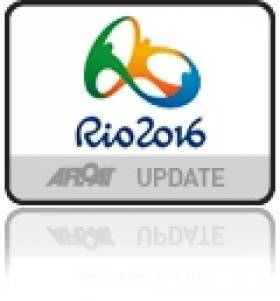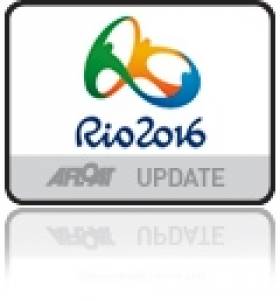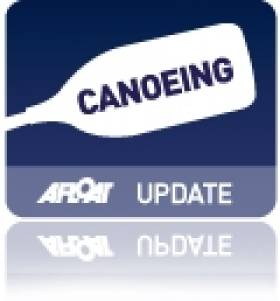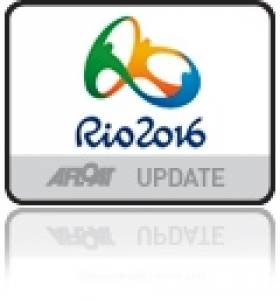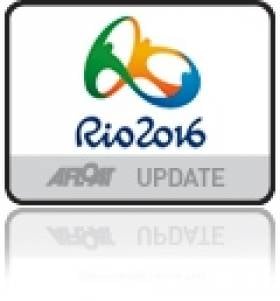Displaying items by tag: Rio 2016
Latest World Rankings Show Irish Olympic Team Improvements
#isafworldrankings – The latest world ISAF sailing rankings published this morning show improvements for Ireland's three Olympic squad members even after last week's 'rusty' performance at the penultimate round of the ISAF World Cup in Palma. Ireland's Annalise Murphy moves into the top 20 overall in the Laser Radial and 49er pair Ryan Seaton and Matt McGovern move up ten to 30th in the world. James Espey moves down two places to 51st in the Laser.
Tom Burton (AUS) led the Laser Medal Race at ISAF Sailing World Cup Mallorca from start to finish taking gold away from overnight leader Tonci Stipanovic (CRO).
The Croatian dropped to third which was enough for him to retain World #1 however Burton is just eight points behind.
There is no change in the top six Laser racers and Ireland's top performer in Palma, James Espey lies 51 in the world rankings, down two places from previously.
Robert Scheidt is one of the big movers as the Brazilian climbs up to World #7 from World #18 whilst Mallorca silver medallist Jean Baptiste Bernaz (FRA) moves a place up to World #11.
An emphatic ISAF Sailing World Cup Mallorca Laser Radial victory by Marit Bouwmeester (NED) handed the World #1 spot back to the Dutch sailor.
Consistency across the 11 race series ensured Bouwmeester gold with a day to spare and as well as world cup honours she regains World #1, a spot she last held in December 2012.
Tuula Tenkanen (FIN) took silver in Mallorca and moves to World #2 from World #11 whilst bronze medallist Chloe Martin (GBR) sits at World #10.
Evi Van Acker (BEL) slipped out of the medal positions on the last day in Mallorca but a solid fourth promotes her up the rankings to World #15 from World #37.
Ireland's annalise Murphy is ranked 19th up one place from previous.
A solid tenth in Mallorca pushes Julien D'Ortoli and Noe Delpech (FRA) up to World #1 in the 49er. Very little separates the top sailors in the 49er rankings with ups and downs each ranking release.
Peter Burling and Blair Tuke (NZL) took the honours at ISAF Sailing World Cup Mallorca and hold a perfect ranking score of 500 points having won the 49er World and European Championships in 2013. Counting the three regattas they sit at World #33 but will certainly be the ones to beat as the year progresses.
Ireland's Ryan Seaton and Matt McGovern lie 30th up ten places from previous.
Full rankings are published here.
Star Class Officially Out Of 2016 Olympics
#Star - It's been confirmed that the Star, the last keelboat event among the Olympic sailing classes, will not be a part of Rio 2016.
Despite hopes that the class would find a place in the schedule for the next Olympic Games - especially after Brazil's president threw her support behind the cause - Scuttlebutt reports that the decision was made final at a meeting of the IOC in Sochi this week ahead of the Winter Olympics.
It's a blow to Brazil's own sailing community, which has claimed six golds in the Star in the past and finished on the podium in the last two Games.
And closer to home, the decision also scuppers chances of Peter O'Leary and David Burrows making another run at Olympic gold in the Star - but it's surely not the last we've seen of them on the world sailing stage.
#Olympics - Annalise Murphy might be preoccupied with next week's Miami regatta, but the main focus for her and fellow Providence Team IRL members will be the Olympic qualifier in Santander this coming September.
As The Daily Sail reports, "the target is to qualify Ireland in all classes" - and the road to Rio begins in earnest next week at the Olympic classes regatta in Florida, where Murphy will be in action in the Laser Radial alongside the Sonar trio of John Twomey, Ian Costello and Austin O’Carroll, who are in the running for Paralympics spots.
Providence Team IRL - rounded off by Laser sailor James Espey and 49er duo Ryan Seaton and Matthew McGovern - is the name given to the elite of the elite by the Irish Sailing Association's (ISA) Performance department, which is at present developing 102 sailors through its Performance Pathway from junior through to the highest level.
Among them are the up-and-coming Olympic Development Squad, with Andrew Brewster and Saskia Tidey in the new 49erFX class, and the Laser Development Squad, which counts the high-achieving teens Finn Lynch and Fionn Lyden in its ranks.
The Daily Sail has more on the story HERE.
Kitesurfing Will Be 'First Alternate' At Tokyo 2020
#Kitesurfing - There's been some good news for kitesurfing on the Olympic front as Surfer Today reports that the kiteboarding class will be the first alternate for the Tokyo Games in 2020.
It was announced at the 2013 ISAF Annual Conference in Oman that kiteboarding will be first in line if additional medals are allocated by the International Olympic Committee (IOC) for sailing in Tokyo in seven years' time.
In addition, the ISAF Council decided that class status will be awarded to the Formula Kiteboard and Twin Tip Kiteboard among a number of newly recognised sailing classes.
The news follows the recent message from the ISAF that kitesurfing would add an 'urban sport' feel to the Olympic programme should it be reinstated.
Kitesurfing was to be included in Rio 2016 at the expense of windsurfing only for the decision to be reversed in Dun Laoghaire a year ago.
Canoeing Ireland Sets Off On Road To Rio Paralympics
#Canoeing - With para-canoeing set to join the list of sports at the Rio Paralympics in 2016, Canoeing Ireland says it is keen to develop the sport and identify and support athletes with hopes of representing Ireland.
That was the message from Canoeing Ireland's Olympic Sprint chairman Eamon Fleming, who was on hand to thank Paralympics Ireland for accepting Canoeing Ireland into the Paralympics family at an event last week.
"We are very excited to be a part of the Paralympics family and see great potential in growing para-canoeing in the future," he said.
According to Fleming, he and Ireland's canoe sports governing body "were inspired to see para-canoeist Patrick O'Leary finished second in the men's 200m event in very tough conditions" at the first sprint regatta of the year in Nottingham last weekend.
Also now paddling his own canoe for Rio is two-time rowing Paralympian Kevin Du Toit, who is currently training out of Richmond Canoe Club in London – a home away from home for Irish paddlers over the years.
Karl Dunne, CEO of Canoeing Ireland, said: "We are delighted to have had instant success with Patrick's result in Nottingham, He will now compete at the European Championships in Portugal this summer.
"Canoeing Ireland look forward to working with Liam and his team on the road to Rio."
Claudine Murphy & Andrea Brewster. 49er FX Skiff Campaigners
Annalise Murphy's older sister Claudine has announced plans to join Annalise on Rio's Guanabara Bay in the latest Irish women's skiff campaign.
Claudine has teamed up with former British trialist Andrea Brewster in a bid for the Irish 49erfx slot against Tiffany Brien and Saskia Tidey also seeking a place in the official squad and a place in this new class for the Rio games.
Here Claudine gives some background on her campaign:
I met Andrea for the first time at the 2004 Laser Radial Europeans in Bangor. Andrea has been sailing the laser full time since then and was Annalise's training partner for the London Games. Annalise had joked about us teaming up in the FX for 2016 but we did not look into it seriously until February of this year. Andrea has dual citizenship so decided to use this to team up with me and start a campaign. She has been in the top 30 in the world consistently from 2005 to 2012 in the laser radial, her most notable result being a bronze medal at the 2008 Laser Radial Worlds. We both decided we had similar ambitions in our sailing and are at a position to go full time to give it a proper go.
We intend on debuting at Sail for Gold in Weymouth where we have been training for the past five weeks. Portland harbour is ideal for learning how to skiff sail as it is large and relatively obstacle free! We then plan on attending the next European cup event in Kiel followed by the Europeans in Denmark. There is then quite a large gap until the worlds in Marseille in mid September.
Our short term goals are to make ISC funding so we can progress forward into 2014 with support. Our main goal for now is to learn to control the boat in all conditions. Skiff sailing in a breeze is more extreme than any kiteboarding or skiing I have done in my last year of travelling! We have had some very comical scenarios in this learning process which makes the terror and injuries sustained worthwhile! I am also very glad of the fitness I worked on last year when I rowed for DULBC while doing my Masters in Trinity. Skiff crewing is very physical so my fitness regime has increased dramatically in the past few months. Long term it will be important to qualify the nation in Santandar next September as it will be much more difficult to do so with the new continent divisions in nation places for 2016.
I think the difficult thing about sailing a double handed boat is finding somebody you can have a successful working partnership with. But I am delighted to have found somebody to sail with who is so talented and dedicated to Olympic sailing as Andrea is. We are basing ourselves in DunLaoghaire from now so between ourselves and Annalise in her moth we will give the pier onlookers lots of entertainment this summer!
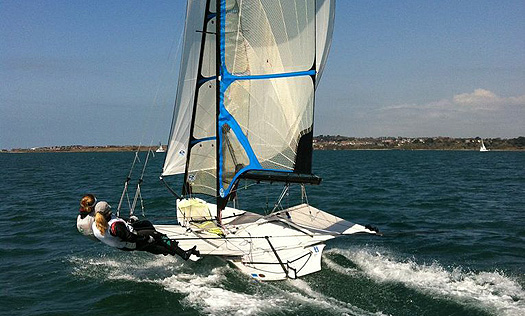
Claudine and Andrea in flying form in a training session in Weymouth. Photo:Tom Peel
Below Andrea also gives some background to the new campaign:
Towards the end of last year I made the decision to sail the 49erFX which is the new Women's Skiff Class in for Rio 2016. The FX is by far the most exciting class ever to be brought in for Women to sail at the Olympics and I could not resist the opportunity to sail full time in such a fantastic boat. So I bought an FX and with the help of some good friends I began learning to try and master the art of skiff sailing.
The difficulty I have found about learning to sail the FX is that as a beginner its fairly risky to go sailing in anything much above 15 knots so that immediately reduced the amount of days I was able to train. Between October and March I think I managed to do about 3 weeks of sailing in total as either there was too much wind or I was unable to find anyone to sail with. I started looking for someone to team up with to get a campaign underway back in September and despite trying out with some very good sailors I was unable to find anyone in a position to be able to sail full time with me. After such a slow start and still no full time crew I was beginning to wonder if I was realistically going to be able to continue campaigning. I thought back to conversations I'd had with my great friend and training partner for the last few years in the Radial, Annalise Murphy from Ireland. We used to joke that I should become Irish and sail a skiff with Annalise's sister Claudine for 2016. At the time it sounded pretty far fetched but nearly 6 months after buying my FX and no further on with a campaign I realised that this might be the only opportunity I might have. My Mum's side of the family are all of Irish descent, so I knew that I could be eligible to sail for Ireland. After talking it through with Claudine and discovering that she was also at a cross roads in life which meant she could go full time if sailing if she wanted, we decided to try out together in the FX. We discussed things in great detail and I was pleased to learn that we both shared the same aspirations for the campaign and from there we decided to seize the opportunity and go for it!
So I am now pleased to officially announce that Claudine Murphy and I are campaigning for Rio 2016 sailing for Ireland. We are only a few weeks into our training so far but as you can see from the picture we are throwing ourselves into it!
I am very grateful for all the support and encouragement I have received so far from everyone about my decision to switch to sail for Ireland. I have many fond and proud memories of my time representing Britain and I am now looking forward to this next exciting chapter in my life!
Videos Get Up Close With Annalise Murphy
#Annalise - A new series of videos (via Sailfeed) peers into the world of Afloat.ie Sailor of the Year and Olympic hopeful Annalise Murphy as she readies herself for her next Olympic campaign.
With little more than three years to go till the first races in Rio, Ireland's top Laser Radial prospect discusses her commitment to the sport and the hard work she's determined to put in between now and 2016.
And it almost goes without saying that the whole of Ireland will be behind 'The Irish Lever' all the way as she takes on the best of the best in Brazilian waters.
More from Annalise below:
Annalise Murphy Interview - The Journey from Atomic on Vimeo.
Annalise Murphy - The Journey/The Gathering from Atomic on Vimeo.
O'Leary & Burrows Could Go For Gold In Rio as Star 'Secures A Slot' UPDATED
UPDATE: The governing body for the Star class is reporting that the earlier news of its reinstatement in the Olympics for 2016 is still "just a rumour".
In a statement, International Star Class Yacht Racing Association (ISCYRA) president Bill Allen said that while the Olympic committee in Brazil "may request an 11th medal for sailing", no decision has yet been made and likely will not be made until summer at the earliest.
"The spreading of rumours concerning Olympic status does not help our position," he added, saying he would inform Star class membership with any new developments as and when they arise.
#Rio2016 - Ireland's Star sailors Peter O'Leary and David Burrows could have another shot at Olympic gold in Rio if the latest news from the IOC is to be believed.
Sailing Anarchy reports that "the ink is dry" on an agreement to secure a place for the Star class in the sailing schedule at the 2016 Olympic Games in Rio de Janeiro.
The move is thanks to a "quirk" in IOC regulations that allow the host country of any Olympic Games to add an event of their own choosing, provided the hosts cover the costs.
And with local sailing duo Robert Scheidt and Bruno Prada in the Star's top ranks - claiming the bronze in London 2012 - the return of the class certainly seems a no-brainer.
The only question remaining now is whether O'Leary and Burrows - who finished 10th in the class at Weymouth last summer - want to go for gold one more time in Rio!
Olympic Games Rio 2016
The 2016 Summer Olympics, officially known as the Games of the XXXI Olympiad, is a major international multi-sport event due to be celebrated in the tradition of the Olympic Games, as governed by the International Olympic Committee (IOC). The host city of the Games will be Rio de Janeiro, Brazil. They are scheduled to be held from August 5 to 21, 2016, making these the first Summer Olympics to be held during the host city's winter. There will be 30 competition venues mainly in Barra da Tijuca, but also in three other zones: Copacabana, Deodoro, and Maracanã. It will mark the first time a South American city hosts the event, the first to host the hemisphere's winter, and also the first time a Lusophone (Portuguese-speaking) country hosts the event.
RYA Statement on Reintroduction of RS:X Windsurfing for 2016 Olympic Games
#rya – The Royal Yachting Association (RYA) has welcomed the decision by delegates at the International Sailing Federation's (ISAF) General Assembly to re-introduce RS:X windsurfing for the 2016 Olympic Games in place of kiteboard racing.
ISAF Council voted to replace the men's and women's windsurfing disciplines with men's and women's kiteboard racing at its mid-year meetings in May of this year, and again reaffirmed this position at its meeting yesterday, but the wider ISAF membership reversed the decision at the General Assembly today, voting in favour of RS:X windsurfing for the Rio Games.
RYA Racing Manager and Performance Director John Derbyshire said: 'This is what the membership of the RYA asked for – we have a very strong youth pathway and some 10,000 windsurfing members of the RYA, so on their behalf we are delighted with the decision.
'We obviously have great compassion towards the kiteboarding community, with whom we have been working very closely, and I am sure that they will continue to work very closely with both the RYA and ISAF families with a view to gaining inclusion for the discipline in future Olympic Games.
'We can now look forward to preparing for Rio 2016 with the clarity that this decision brings.'
The events for the Rio 2016 Olympic Sailing competition are now confirmed as:
Men's Board - RS:X
Women's Board - RS:X
Men's One Person Dinghy – Laser*
Women's One Person Dinghy - Laser Radial*
Men's second One Person Dinghy - Finn
Men's Skiff - 49er*
Women's Skiff – 49erFX*
Men's Two Person Dinghy - 470
Women's Two Person Dinghy - 470
Mixed Two Person Multihull – Nacra 17
*The Laser, Laser Radial, 49er and 49erFX have also been approved as Core Events and Equipment for the 2020 Olympic Sailing Competition.
Derbyshire also offered the RYA's congratulations to the new ISAF President Carlo Croce (ITA), who was voted to serve an initial four year term. Great Britain's Chris Atkins was voted as one of seven new ISAF Vice Presidents and will also serve an initial four year term as part of the organisation's Executive Board.


























